Coronavirus Today: As Omicron arrives, perhaps ‘we should be rooting for Delta’
Good evening. I’m Karen Kaplan, and it’s Friday, Dec. 3. Here’s the latest on what’s happening with the coronavirus in California and beyond.
Well, that didn’t take long.
On Monday, President Biden warned Americans that “sooner or later, we’re going to see cases of this new variant here.” Unbeknownst to him, a San Francisco resident had already brought the Omicron variant onto U.S. soil as an unwelcome souvenir of a trip to South Africa.
The unidentified resident — a fully vaccinated adult between the ages of 18 and 49 — arrived home on Nov. 22 feeling completely fine. A few days later, the traveler began to feel unwell and got tested Sunday, Nov. 28. Confirmation of a coronavirus infection came back Monday.
The next afternoon, a specimen from the patient made its way to a lab run by Dr. Charles Chiu, an infectious disease specialist at UC San Francisco. Chiu routinely sequences the genomes of samples to keep track of the variants circulating in the community.
Across the country, the Delta variant accounted for 99.9% of all sequenced coronavirus specimens, according to the Centers for Disease Control and Prevention. But the one in Chiu’s lab was a rare exception.
It took two hours for results of a rapid molecular test to suggest that the San Francisco patient was infected with Omicron. By 4 a.m. Wednesday, the team had assembled enough of the genome “to conclusively demonstrate that this was, indeed, an infection from the Omicron variant,” Chiu said.
The patient had mild symptoms and was already improving by Wednesday, health officials said. The resident is self-isolating to reduce the risk of transmission. Contact tracers have identified the traveler’s close contacts, and all have tested negative so far, according to the CDC.
The following evening, officials in Los Angeles County reported their first case of a resident infected with the Omicron variant. Like his or her counterpart in San Francisco, the unidentified Southland patient was fully vaccinated and had traveled to South Africa the previous week. The patient’s symptoms were already “improving without medical care,” L.A. County health officials said in a statement.
“A small number of close contacts in Los Angeles have been identified and, to date, all have tested negative and have no symptoms,” the statement added.
There have been no signs that either patient has touched off a larger outbreak, and state officials said they didn’t think Omicron’s presence would require them to reimpose lockdowns or other restrictions.
“There’s more panic than information around this new variant,” Gov. Gavin Newsom said Wednesday. “And that just means we have to keep our mind open but maintain our vigilance.”
State and local health officials are coordinating with the CDC to set up a free rapid coronavirus testing site at Los Angeles International Airport’s international terminal. People who test negative will be given a kit so they can test themselves again three to five days later, as the CDC recommends. (Testing at LAX is voluntary.)
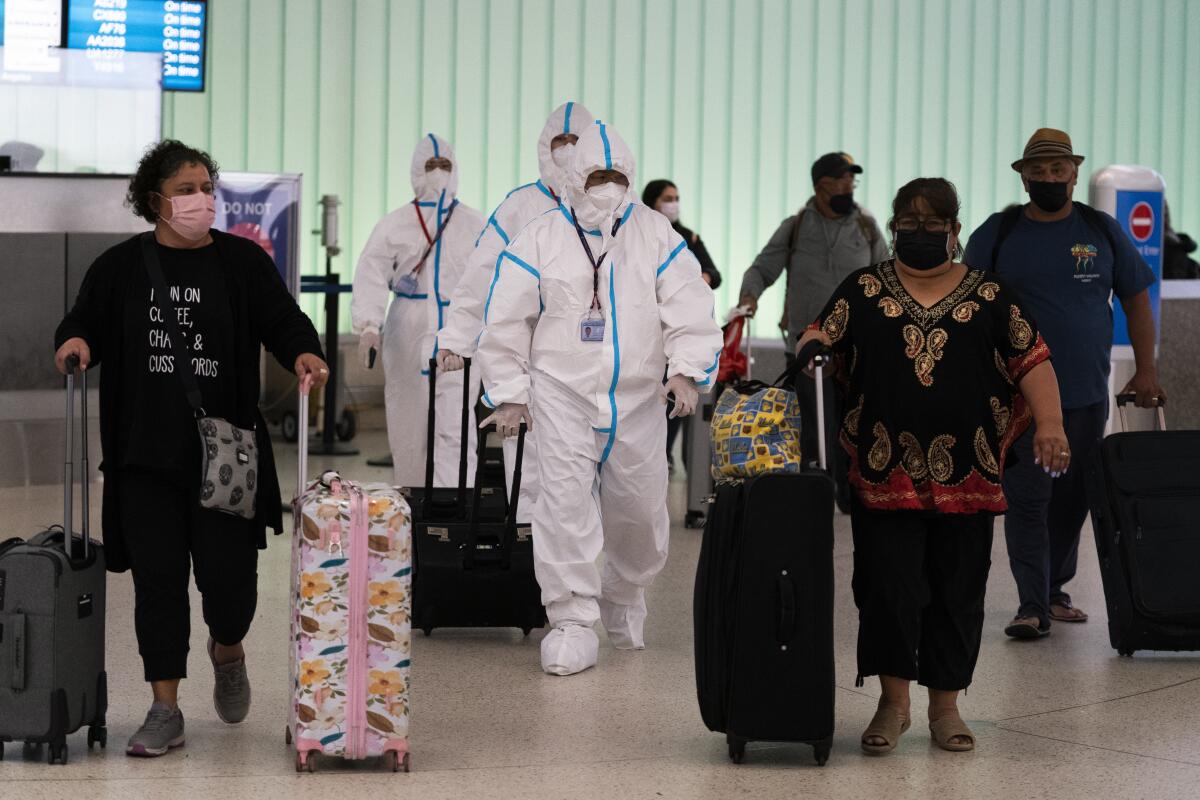
The county also said it would ask skilled nursing facilities to step up their routine tests of residents and staff.
Expanded testing is one of the primary pillars of a winter response plan Biden unveiled Thursday.
The Biden administration will distribute 50 million rapid tests to community health centers and rural clinics, where they’ll be available free to people without health insurance. Those who are insured can get reimbursed for the full cost of tests they purchase.
Other than that, Biden and his public health team are counting on vaccines to protect Americans against an Omicron surge. Although scientists in South Africa said they thought past infections offered less protection against Omicron than they did against Delta, they don’t think the same is true for vaccines. The shots, however, only work if people take full advantage of them.
“If you’re worried about the Omicron variant, the best thing to do is get fully vaccinated, and then get your booster shot when you’re eligible,” Biden said. “We don’t yet believe that additional measures will be needed.”
Scientists are well-positioned to keep track of Omicron now that the country has stepped up its coronavirus sequencing efforts.
Earlier this year, fewer than 1% of positive test specimens were being genetically sequenced. Now, thanks to a $1.7-billion investment in Biden’s coronavirus relief bill, the country has a national testing network that includes nearly 70 state and local public health laboratories, which are sequencing a combined 15,000 to 20,000 specimens a week.
Adding in the work of other labs, including some run by the CDC, the U.S. is sequencing 40,000 to 80,000 specimens a week. That amounts to 5% to 10% of all samples — roughly in line with the efforts of other nations.
“We’re in a much, much better place than a year ago or even six or nine months ago,” said Kenny Beckman of the University of Minnesota, who directs a genomics lab that sequences about 1,000 samples a week.
That increased surveillance should help scientists answer a crucial question: Does the Omicron variant have what it takes to overtake Delta?
If it doesn’t, there’ll be little reason to worry about what Omicron’s many mutations allow it to do.
Since Delta established its dominance in the U.S. with its superior powers of transmission, it has effectively elbowed out all other variants that have tried to spread here. We have Delta to thank for keeping the Beta variant — which worried scientists when it emerged from South Africa because it looked like it might be resistant to COVID-19 vaccines — at bay.
“Beta was squelched out by Delta,” said John Moore, a professor of microbiology and immunology at Weill Cornell Medical College. “That could happen to Omicron.”
The fact that Omicron has spread rapidly in South Africa doesn’t necessarily mean the same is bound to happen here. Delta does not have a stranglehold on Africa like it does on the U.S., and it’s possible Omicron is gaining ground there at the expense of the Alpha and Beta variants, Moore said.
Delta hasn’t exactly been kind to Americans, racking up a six-figure death toll already and killing about 6,000 more of us each week. But at least we know that vaccines offer strong protection against serious illness and death.
“We should be rooting for Delta,” Moore said. “Better the devil you know than the devil you don’t.”
By the numbers
California cases and deaths as of 4:52 p.m. Friday:

Track California’s coronavirus spread and vaccination efforts — including the latest numbers and how they break down — with our graphics.
Standing up for freedom or ‘looking to kill people’?
Oroville Vice Mayor Scott Thomson wasn’t exactly thrilled when the government told him he had to wear a face mask to try to stop the coronavirus from spreading. He bristled when the government put new limits on businesses in the name of fighting the pandemic.
California’s COVID-19 vaccine mandate for healthcare workers was harder to take. And when the state declared that children would have to get a COVID-19 vaccine as a condition of coming to school, it was simply too much.
Thomson did not think the 20,000 residents of his Northern California city should have to be subject to such rules. So he came up with a plan to have Oroville declare itself a constitutional republic. As such, it would not enforce any federal or state order that it deemed to be in violation of its citizens’ constitutional rights, my colleague Hailey Branson-Potts reported.
“For every society you have to have laws, but for each law that comes, that does mean a forfeit of some sense of freedom,” Thomson explained at a City Council meeting last month. “It’s time for us to draw a line in the sand and say, ‘Enough is enough.’”
As it happens, Thomson was not the only council member who didn’t like being told what to do. The declaration passed by a vote of 6 to 1. (You can watch the debate here, beginning at 41:14.) When the final vote lighted up on a screen in the council chambers, members of the public whooped and clapped.
Not everyone was celebrating, however. An older man who attended the meeting expressed his concern that “these ‘constitutional republic’ people would probably prevent mask mandates.”
“In other words,” he said, “they’re looking to kill people.”
Oroville resident Celia Hirschman described the declaration as “dangerous.” In her view, the pandemic safety measures were not an assault on personal freedoms but a way to save lives, and the council’s decision to snub them is an insult to people like her who have lost loved ones to COVID-19. (Her father died of the disease three months ago.)
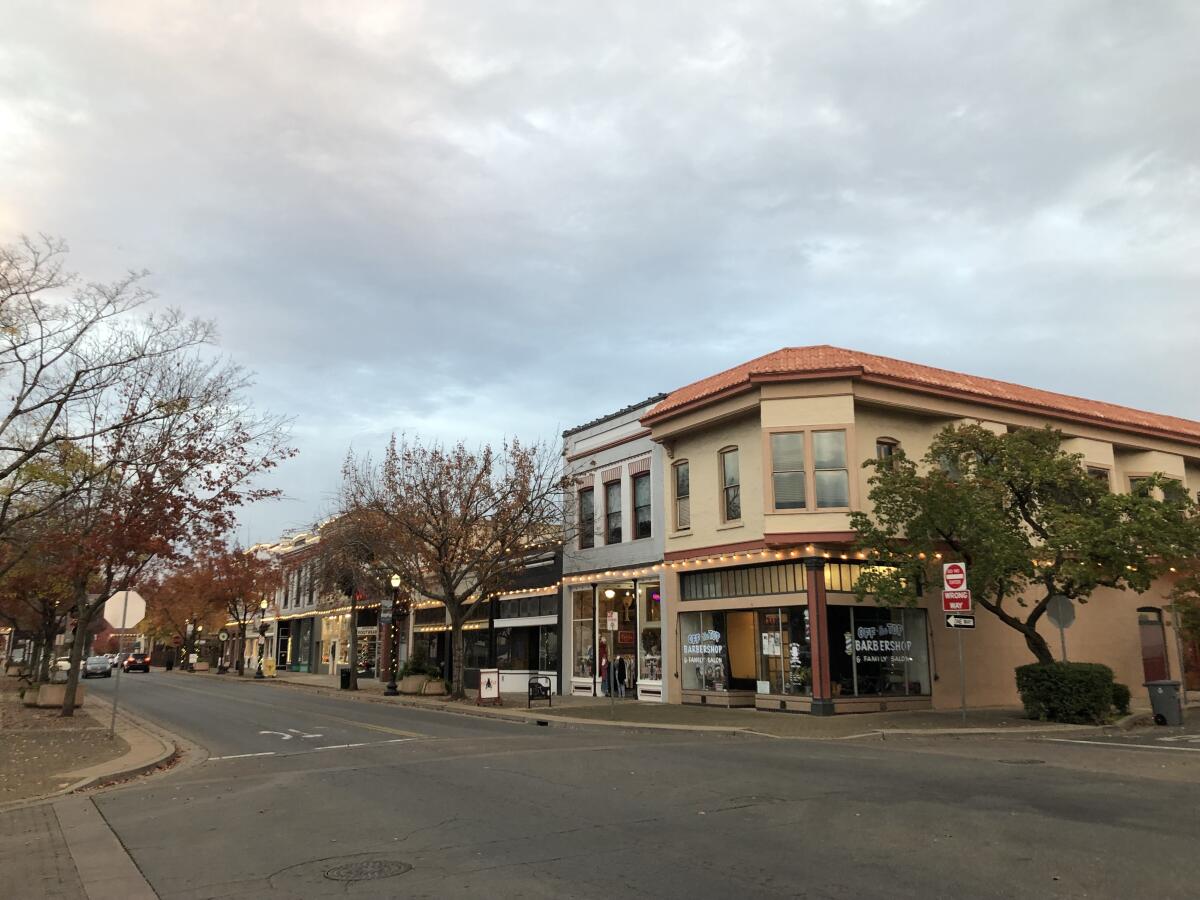
But that was a minority view. Indeed, the local vaccination rate may be viewed as evidence of the public’s resistance to government edicts.
Oroville is the seat of Butte County, where just 52.1% of residents are at least partially vaccinated against COVID-19 and 47.2% of them are fully vaccinated, according to the Times Tracker. Those numbers are well below the statewide figures of 72.3% and 64.5%, respectively.
Oroville isn’t the first California city to get creative in expressing its exasperation with pandemic rules. Atwater, in Merced County, declared itself a “sanctuary city for business” last year when statewide stay-at-home orders were in effect. Coalinga, in Fresno County, deemed all of its businesses essential.
Those stands were more than symbolic — they cost the towns hundreds of thousands of dollars in emergency COVID-19 funds. Not incidentally, coronavirus cases surged as well.
Oroville is now dealing with relatively high case rates. In the last two weeks, the town averaged 89 new coronavirus cases per 10,000 residents. By contrast, downtown Los Angeles averaged 27 cases per 10,000 residents during that time, and San Francisco’s Sunset District averaged just 7 per 10,000 residents.
Thomson, the City Council member, said he wasn’t opposed to pandemic precautions. He said he was fine with COVID-19 vaccines for those who wanted them, and city employees who don’t want them get tested for coronavirus infection once a week. The Assembly of God church, where he is pastor, has distributed hundreds of masks.
But, Thomson said, there’s a difference between choosing to protect yourself and having rules thrust upon you: “OK, now you’re, in my opinion, crossing the line.”
California’s vaccination progress
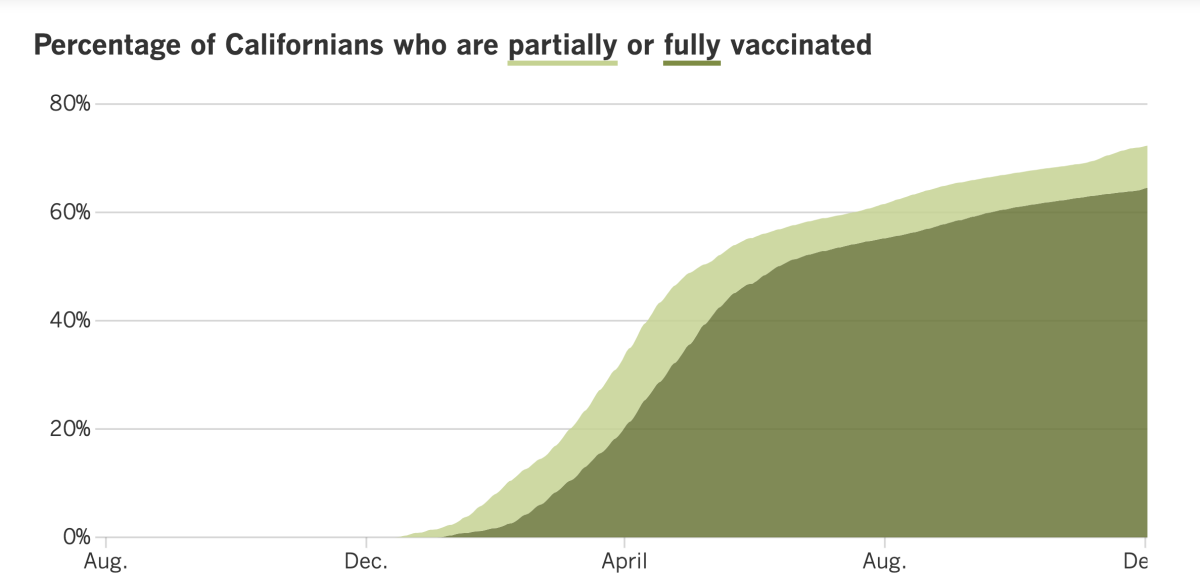
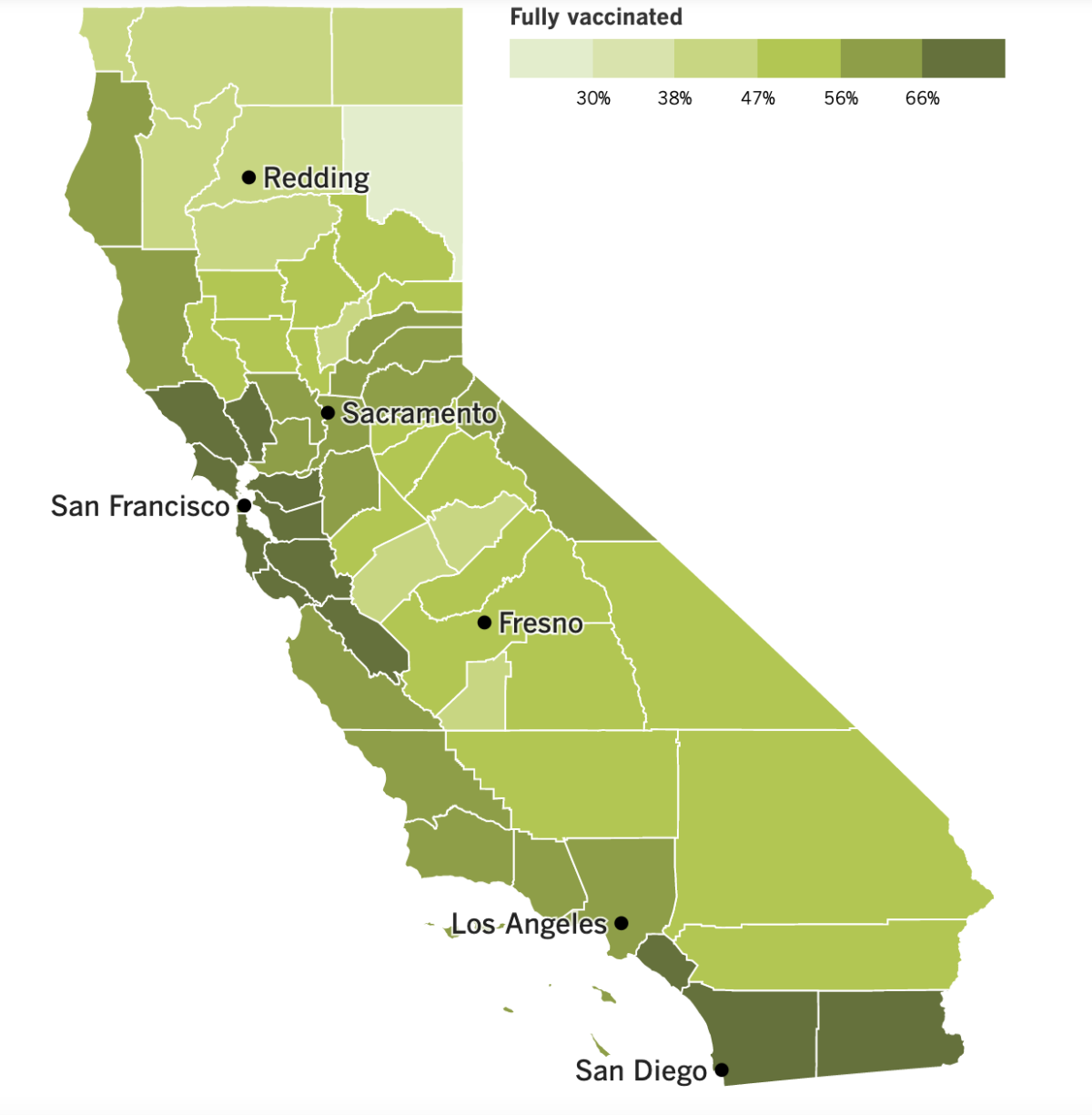
See the latest on California’s vaccination progress with our tracker.
Your support helps us deliver the news that matters most.
In other news ...
COVID-19 vaccines have been a contentious issue in San Diego County. Although nearly 83% of residents there are at least partially vaccinated and almost 70% are fully vaccinated, some of the holdouts are digging in.
That includes about 700 members of the San Diego Police Department. As of last week, about 37% of the police force remained unvaccinated despite a requirement that city employees get immunized. City leaders were able to negotiate agreements with five of the six labor unions that represent its workers. But they are at an impasse with the San Diego Police Officers Assn., which strongly opposes the vaccine mandate.
So on Monday, the San Diego City Council voted 8 to 1 — twice — to move forward with its vaccine mandate. Those who don’t comply by the end of December will face termination.
“The way out of this pandemic is through vaccines,” Mayor Todd Gloria said, “and the city of San Diego should lead by example.”
Exemptions are available for medical or religious reasons, and the city has received at least 394 of them. More than 40% were from police officers. Overall, about 2,000 city workers are still unvaccinated.
A vaccine mandate for students in San Diego Unified School District has been put on hold by the U.S. 9th Circuit Court of Appeals. Under terms of the mandate, students ages 16 and up were supposed to have received their first dose of the Pfizer-BioNTech vaccine by Monday and be fully vaccinated by Dec. 20. Students who don’t comply would be required to attend school remotely.
The legal challenge to the mandate was brought by a 16-year-old student at Scripps Ranch High School who argued that her Christian beliefs prevented her from taking the vaccine because it was tested on a cell line grown from kidney cells obtained from an abortion in 1973. (The vaccine itself does not contain fetal cells.)
Another school district in the county, Alpine Union, said it is working on a way to allow unvaccinated students to keep attending classes in person — despite a statewide requirement that they get vaccinated against COVID-19 if they want to come to campus.
Alpine Union has a history of leniency. It was the first district in San Diego County to reopen last year, and it tried — unsuccessfully — to defy the state’s indoor mask mandate for all students and teachers.
The latest effort would create an Alpine Choice Academy, an off-campus location where unvaccinated students can learn together from teachers in the district. The goal would be to keep the school day as normal as possible for these students, Supt. Rich Newman explained.
Newman insisted he wasn’t playing politics by pursuing the off-site academy. In fact, he said, not only is he fully vaccinated, but he’s also received a booster shot.
“For whatever reason, if the parent chooses not to vaccinate them, I still believe that a student deserves every opportunity to reach their potential,” Newman said. “These are kids. They don’t have a say in what their education is. They’re caught in the middle of a political environment right now.”
And before we leave San Diego, there’s this: The Sheriff’s Department said 125 inmates in county jails have tested positive for coronavirus infections in the past week, and they’re waiting for results for another 188 people. Officials suspect the deaths of two inmates are linked to the outbreak, though the cases are still under investigation. Another inmate is gravely ill with COVID-19.
To get the situation under control for both inmates and staffers, the jails have moved into full lockdown mode. That means incarcerated people can’t visit with relatives, friends or their attorneys. Instead, they must remain in their cells for up to 23 hours a day.
Speaking of outbreaks, Amazon has been accused of providing “misleading or grossly incomplete” information about the number of coronavirus infections its employees may have picked up in its U.S. facilities.
The Strategic Organizing Center, a labor group whose members include the International Brotherhood of Teamsters and the Service Employees International Union, said that although nearly 20,000 Amazon employees became infected last year, only 27 of them may have caught the bug at work. The numbers were based on a review of workplace illness and injury documents submitted to the U.S. Department of Labor.
One thing that seemed fishy to the center: County health department records about outbreaks in Los Angeles, Salt Lake City and a Portland, Ore., suburb called Troutdale identified more than 750 cases among Amazon workers. The company’s filings suggest not a single one of them was work-related.
“That defies science and logic,” said Eric Frumin, the center’s health and safety director. He called on the federal government to investigate the company.
Amazon responded to the report by saying that it interviewed its employees to determine their risk of exposure, adding that no less an authority than the Occupational Safety and Health Administration has acknowledged how hard it can be to prove whether someone caught the coronavirus on the job. The company disputed the center’s conclusions.
A forthcoming book by President Trump’s chief of staff says the former commander in chief tested positive for a coronavirus infection three days before he shared a debate stage in Cleveland with his Democratic challenger, Joe Biden.
The positive test result came in on Sept. 26, 2020, the day Trump held a Rose Garden ceremony to introduce Amy Coney Barrett as his nominee to replace Ruth Bader Ginsberg on the Supreme Court. Mark Meadows, the chief of staff, got the news as Trump was flying by helicopter to a campaign rally in Pennsylvania, according to a copy of the book obtained by the Guardian.
Meadows writes that he informed his boss that the test had been conducted with an older kit, so it was repeated with a newer one. This time, the test came back negative. Trump took that as “full permission to press on as if nothing had happened,” Meadows wrote. He attended a variety of public functions before the debate.
Three days later, he announced in a tweet that both he and wife Melania had tested positive for infections. The then-president was admitted to Walter Reed National Military Medical Center later that day.
And finally, here’s a scary number from Jens Spahn, Germany’s health minister: 1%. That’s the percentage of the country’s residents who are currently infected with the coronavirus. If Americans were impacted at the same rate, that would translate into more than 3.3 million active infections.
Your questions answered
Today’s question comes from readers who want to know: Where did the Omicron variant come from?
We’ll probably never know for sure, but scientists have a strong suspicion that it arose in a COVID-19 patient whose immune system was already compromised by another serious medical condition. As a result, it would have taken an inordinate amount of time to clear the coronavirus from his or her system, giving it plenty of time to acquire its constellation of roughly 50 genetic mutations.
Researchers have been warning of such a scenario for months, my colleague Melissa Healy reports. Indeed, it’s been exactly a year since doctors published a report on the so-called Boston patient, a 45-year-old man with a rare autoimmune disorder who battled COVID-19 for 154 days before he died of the disease. During that time, the coronavirus in his body racked up dozens of genetic changes.
There are multiple conditions that can cause a person to become immunocompromised, and one of the most common is an HIV infection that is not kept in check with antiviral medications. In South Africa, there are an estimated 2.2 million people whose HIV is poorly controlled or untreated altogether.
These people could “become a factory of variants for the whole world,” said Tulio De Oliveira, the South African scientist who detected the Omicron variant.
Other researchers agreed with that assessment, including Dr. Jonathan Li, a Harvard infectious-diseases specialist who treated the Boston patient.
“If I had to guess, I would say this is likely how Omicron came about,” Li said.
We want to hear from you. Email us your coronavirus questions, and we’ll do our best to answer them. Wondering if your question’s already been answered? Check out our archive here.
The pandemic in pictures
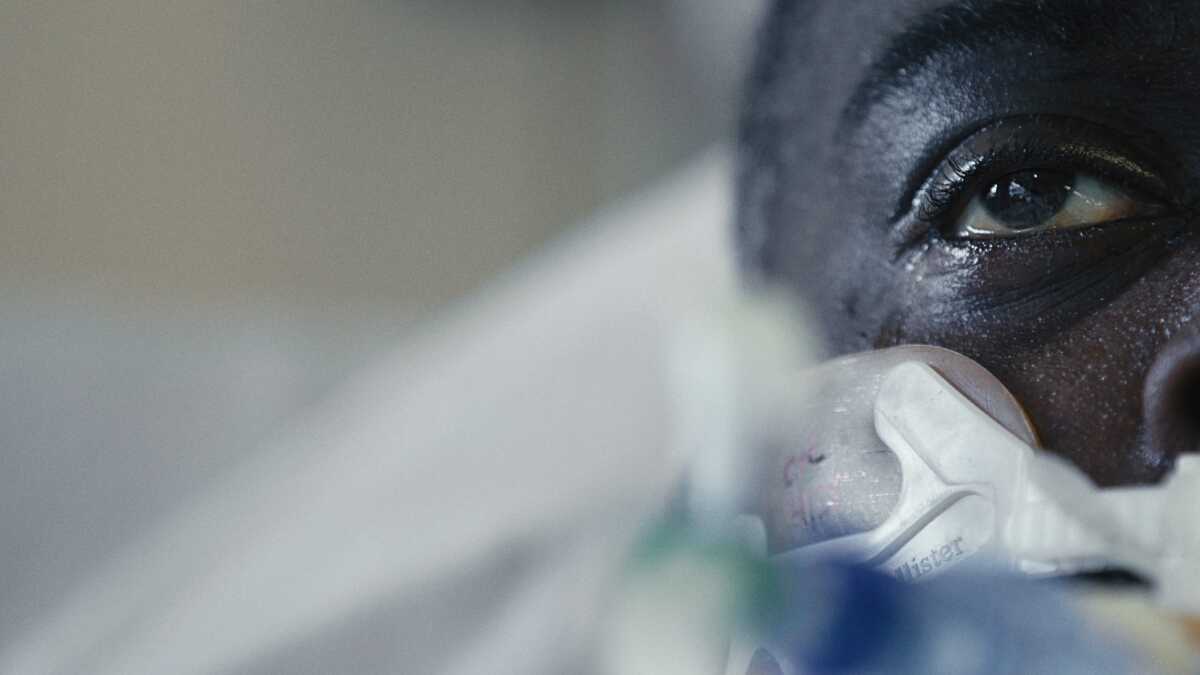
The photo above is a scene from “The First Wave,” a new documentary that takes viewers inside a New York City hospital just as the coronavirus arrived in the U.S. and made the Big Apple one of its first targets.
Filmmaker Matthew Heineman turned his lens on Long Island Jewish Medical Center in Queens, which treated its first COVID-19 patient way back on March 3, 2020. Heineman filmed the hospital’s caregivers and patients from March until June, a time when pretty much everything about the pandemic was an unknown. Doctors were still trying to figure out out how to care for patients with the novel respiratory disease — and to do so without enough ventilators, personal protective equipment, or even beds.
“The First Wave” opened in theaters a week before South African scientists announced they’d detected a new coronavirus variant that was associated with a dramatic rise in infections there. With Omicron now on the scene, the light at the end of the pandemic tunnel feels further away. But this documentary is a potent reminder of how far we’ve come.
Resources
Need a vaccine? Here’s where to go: City of Los Angeles | Los Angeles County | Kern County | Orange County | Riverside County | San Bernardino County | San Diego County | San Luis Obispo County | Santa Barbara County | Ventura County
Practice social distancing using these tips, and wear a mask or two.
Watch for symptoms such as fever, cough, shortness of breath, chills, shaking with chills, muscle pain, headache, sore throat and loss of taste or smell. Here’s what to look for and when.
Need to get a test? Testing in California is free, and you can find a site online or call (833) 422-4255.
Americans are hurting in many ways. We have advice for helping kids cope, resources for people experiencing domestic abuse and a newsletter to help you make ends meet.
We’ve answered hundreds of readers’ questions. Explore them in our archive here.
For our most up-to-date coverage, visit our homepage and our Health section, get our breaking news alerts, and follow us on Twitter and Instagram.




